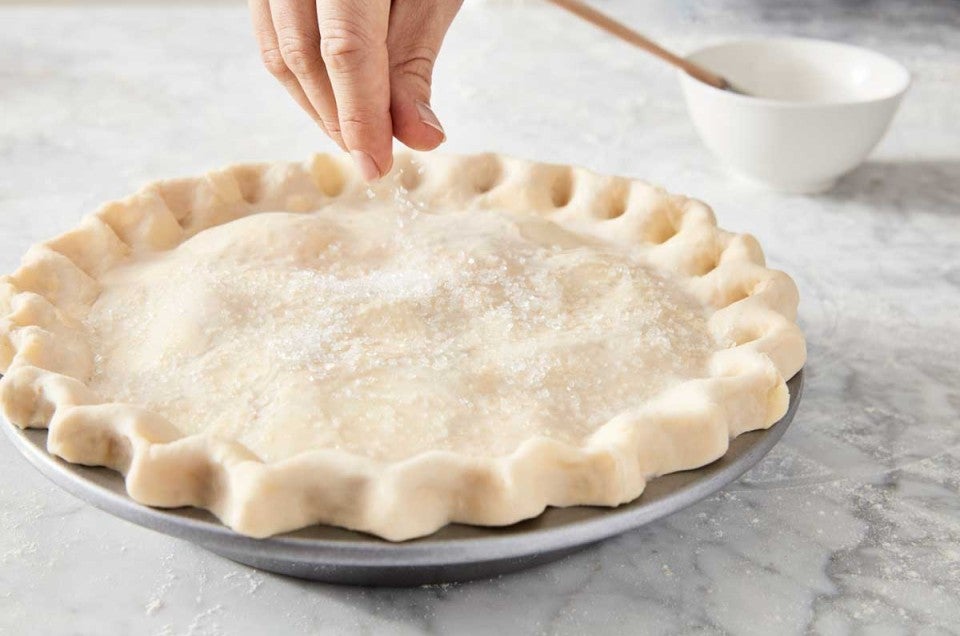


Anointing the top of your pie may seem like gilding the lily — I mean, how can you improve on your already perfect apple pie? But topping pie crust with a spritz of water and a sprinkle of sugar, or a quick brush of sweet butter followed by the merest drift of flour, can take your pie — both its flavor and its texture — to a new level.

Let's start with a base layer that'll support the sugar (and spice) to come.
I've brushed these pastry rounds with some popular crust toppings: egg white wash (egg white + water), water, whole egg wash, milk, and butter. I've also left one round untouched (upper left, the "control"), for comparison.
You can see the results: both of the egg washes, milk, and butter add golden color to crust, with whole egg adding the most. In addition, the two egg crusts have a satiny/shiny finish, where the remaining crusts are basically matte, with perhaps just a hint of shine on the milk and butter crusts.
The butter crust offers a tiny bit more flavor than any of the others, but also has a somewhat speckled appearance, the result of milk solids separating from fat. Of course, if you plan on sprinkling the crust with your favorite sugar, the speckles will disappear.
Now, let's see what happens when we add toppings.

I pile apple pie filling (no bottom crust) into the wells of a hamburger bun pan — which does slick double duty as a mini pie pan.
On top, I place pastry rounds brushed with water (except one that's brushed with butter). Starting at upper left and going to lower right, here are the toppings:

And here they are, baked and ready to enjoy. Let's take a closer look.

Note how regular granulated sugar (left) melts a bit to form shards of sweetness. The cinnamon-sugar (right) adds color and wonderful flavor, but I should have been more careful when sprinkling; the opaque patch signals too thick a coat.

Confectioners' sugar (left) creates a wintry appearance, like hoarfrost on a meadow. The butter/flour coating (right) doesn't result in any flakiness (old wives' tale, I guess); but nonetheless is velvety in texture, and pleasantly buttery.
 Coarse sugar (left) melts just a bit, but retains its crunchy texture and gives the crust some sparkle. Swedish pearl sugar (right) doesn't melt; its bright white color makes the crust stand out in a crowd, and its crunch is a nice complement to the soft apples underneath.
Coarse sugar (left) melts just a bit, but retains its crunchy texture and gives the crust some sparkle. Swedish pearl sugar (right) doesn't melt; its bright white color makes the crust stand out in a crowd, and its crunch is a nice complement to the soft apples underneath.

One additional test pits crust brushed with water (left) vs. crust brushed with beaten egg (right), both topped with coarse sugar.
The water encourages some of the sugar to melt; while the beaten-egg helps the coarse sugar retain its shape as individual crystals. Choose your favorite look.
So, what's the verdict? Bare naked, sugar shards, golden egg...
Personally, I swap these various combinations in and out depending on my audience. There are those in my family who don't care for cinnamon; and some who love crunch; and some who embrace a minimalist approach, with no topping at all or just butter and flour.

And at the end of the day, there's really no need to pick and stick with a favorite; they're all immensely satisfying.
Want to read more about pie? Check out these posts:
Decorative pie crust tips: pastry lattice, braids, and more
Make-ahead pie crust: an old secret rediscovered
How to make pie crust in your stand mixer: easy does it
The very best pie apples
Freeze and bake fruit pie
Perfect pie: a baker's dozen+ tips
Pie crust decorating basics: easy ways to make fancier pies
Apple Pie Bakealong: challenge #4

